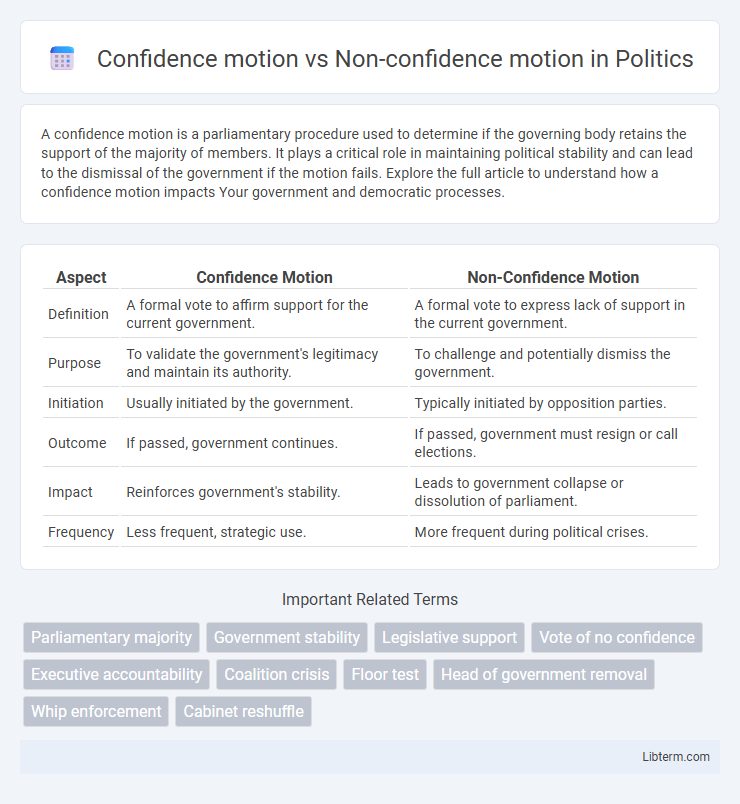A confidence motion is a parliamentary procedure used to determine if the governing body retains the support of the majority of members. It plays a critical role in maintaining political stability and can lead to the dismissal of the government if the motion fails. Explore the full article to understand how a confidence motion impacts Your government and democratic processes.
Table of Comparison
| Aspect | Confidence Motion | Non-Confidence Motion |
|---|---|---|
| Definition | A formal vote to affirm support for the current government. | A formal vote to express lack of support in the current government. |
| Purpose | To validate the government's legitimacy and maintain its authority. | To challenge and potentially dismiss the government. |
| Initiation | Usually initiated by the government. | Typically initiated by opposition parties. |
| Outcome | If passed, government continues. | If passed, government must resign or call elections. |
| Impact | Reinforces government's stability. | Leads to government collapse or dissolution of parliament. |
| Frequency | Less frequent, strategic use. | More frequent during political crises. |
Introduction to Confidence and Non-Confidence Motions
Confidence motions are formal parliamentary procedures used to determine whether a government still retains the support of the majority in the legislative assembly, essential for maintaining its legitimacy and authority. Non-confidence motions specifically challenge the current government's ability to govern and, if passed, often lead to the resignation of the cabinet or the dissolution of the assembly, triggering elections. Both motions serve as critical mechanisms for accountability, ensuring that the government reflects the legislature's confidence and can effectively execute its mandate.
Definition of Confidence Motion
A Confidence Motion is a parliamentary procedure where the government seeks the legislative body's approval to continue in power, often articulated through a formal vote. Its passage signifies the legislature's support for the current administration, while failure typically results in the government's resignation or dissolution of parliament. This mechanism ensures the executive retains the confidence of the elected representatives, maintaining political stability within the parliamentary system.
Definition of Non-Confidence Motion
A Non-Confidence Motion, also known as a Vote of No Confidence, is a parliamentary procedure used to test whether the ruling government still holds the majority support in the legislative assembly. It requires members to vote on the government's capability to govern effectively, and if the motion passes, it often leads to the resignation of the current government or dissolution of the assembly. Confidence motions differ as they are initiated by the government to affirm their legitimacy and maintain authority.
Key Differences Between the Two Motions
Confidence motion is a formal parliamentary procedure used to affirm government support, where failure results in the government's resignation or dissolution of the legislature. Non-confidence motion, or vote of no confidence, specifically challenges the government's legitimacy and can compel it to step down if passed. The key difference lies in their purpose: confidence motions seek explicit approval, while non-confidence motions aim to express disapproval and trigger government change.
Legal Provisions and Parliamentary Rules
Confidence motion and non-confidence motion are critical parliamentary instruments governed by constitutional provisions and parliamentary rules that determine the government's legitimacy. Legal frameworks typically mandate that a confidence motion requires a majority 'yes' vote to affirm the government's mandate, while a non-confidence motion, often guided by specific procedural rules, seeks to demonstrate the government's loss of majority support and trigger its resignation or dissolution of the legislature. Parliamentary standing orders and constitutional articles meticulously outline timelines, admissibility, and voting thresholds, ensuring orderly governance and political accountability through these motions.
Procedures for Introducing Each Motion
Confidence motions require a formal proposal usually submitted by the government or prime minister and must follow specific parliamentary rules, including scheduling for debate and a set time frame for votes. Non-confidence motions can be introduced by opposition members or other parliamentarians, often requiring prior notice or a minimum number of signatures to be accepted for discussion. Both motions undergo procedural scrutiny based on legislative frameworks, but confidence motions typically trigger more immediate political consequences, influencing government stability.
Political Significance and Implications
Confidence motions affirm the government's legitimacy, with failure triggering resignation or elections, reinforcing parliamentary accountability and political stability. Non-confidence motions challenge specific policies or leaders without necessarily dissolving the government, influencing political power dynamics and legislative priorities. Both motions serve as crucial tools for democratic oversight, shaping governance and party alliances within a parliamentary system.
Historical Examples and Case Studies
Confidence motions, such as the 1979 vote of no confidence against the UK Labour government led by James Callaghan, directly test a government's parliamentary support and can lead to its fall if lost. Non-confidence motions, often symbolic, include the 2017 non-binding motion in Spain against Prime Minister Rajoy, which highlighted discontent but did not trigger government change. Historical cases reveal confidence motions as decisive tools shaping government tenure, while non-confidence motions frequently serve as political statements without immediate legal consequences.
Outcomes and Consequences of the Motions
Confidence motions directly test the government's legitimacy, where a passed motion solidifies the administration's authority, while failure mandates resignation or an election, leading to potential government collapse. Non-confidence motions, often called no-confidence motions, result in similar consequences but can also be used as strategic tools by the opposition to challenge specific policies without necessarily triggering full government dissolution. The outcomes of these motions critically influence parliamentary stability, policy continuity, and public trust in governance.
Conclusion: Importance in Democratic Governance
Confidence motions ensure the ruling government maintains the support of the legislative majority, acting as a critical mechanism for political accountability and stability. Non-confidence motions enable legislatures to challenge and potentially replace ineffective or unpopular governments, reinforcing democratic checks and balances. Together, these motions uphold the principles of representative democracy by securing government legitimacy and responsiveness to elected officials and the public.
Confidence motion Infographic

 libterm.com
libterm.com